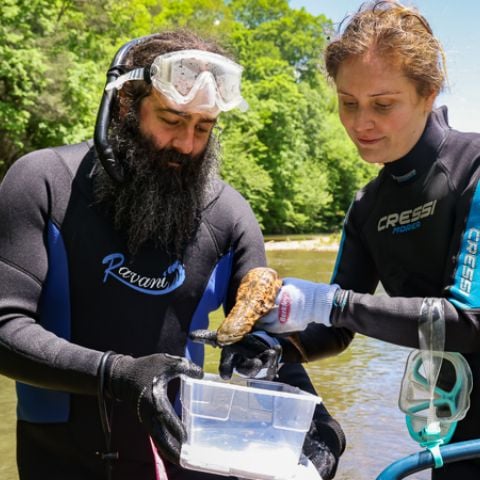Summary of Releasing Hellbenders into the Wild 2025:
Last week, the Nashville Zoo, in partnership with the Tennessee Wildlife Resources Agency and Tennessee State University, released 17 eastern hellbender salamanders back into the wild in Middle Tennessee. These salamanders were raised at the zoo as part of a headstart program aimed at bolstering the population of this state-endangered species. Since the program’s inception, over 120 hellbenders have been released. The salamanders, raised since 2018, were equipped with radio transmitters to allow monitoring. This is the fifth release since 2021. The headstart program addresses the rapid decline of hellbenders, once widespread in the Eastern US, by raising them in captivity and releasing them to sustain wild populations. Nashville Zoo has also achieved significant breeding success, including the first captive breeding of eastern hellbenders. The zoo aims to further support these salamanders by establishing an outdoor, artificial stream for breeding. Conservation efforts include not disturbing river rocks, which are crucial to their habitat.
- The release of hellbenders into the wild aims to restore endangered populations in Tennessee.
- The headstart program at Nashville Zoo plays a crucial role in raising and releasing hellbenders.
- Successful breeding initiatives at the zoo have utilized biotechnology and cryopreservation.
- Partnerships with local institutions enhance conservation efforts.
- Future plans involve expanding habitat and breeding facilities to support hellbender populations.
Releasing Hellbenders into the Wild 2025
The conservation of the eastern hellbender salamander has become a landmark effort in Tennessee, underscoring the importance of biodiversity and ecosystem health. With its distinctive wrinkled skin and aquatic lifestyle, the eastern hellbender plays a key role in freshwater ecosystems. Unfortunately, due to habitat degradation and declining water quality, these creatures are now endangered.
In 2025, a significant step was taken by the Nashville Zoo in partnership with the Tennessee Wildlife Resources Agency and Tennessee State University. This collaboration led to the release of 17 eastern hellbenders into a Middle Tennessee waterway. This initiative is part of a broader strategy to bolster the dwindling populations of this state-endangered species through a comprehensive headstart program.
The Headstart Program: A Solution to a Pressing Problem
The decision to initiate a headstart program for hellbenders was not taken lightly. Once abundant across the Eastern United States, hellbenders have faced severe population declines over past decades. Increased sedimentation, pollution, and habitat destruction have affected their survival. Recognizing the alarming decline, Nashville Zoo instituted a headstart program designed to rear hellbenders from eggs to viable young adults ready for release.
This program is especially vital due to the species’ extended developmental period. Hellbenders can take several years to reach maturity, making them particularly vulnerable in the early stages. By raising them in controlled environments and then releasing them, conservationists can improve their chances of survival.
Success in Hellbender Breeding: Harnessing Biotechnology
The Nashville Zoo’s remarkable achievements in breeding hellbenders have shattered previous barriers in amphibian conservation. Notably, the zoo’s herpetologists achieved the first successful captive and controlled breeding of hellbenders using advanced biotechnological methods. In 2012, the team pioneered the use of controlled environments to stimulate natural breeding behaviors.
A breakthrough came in 2015, when cryopreserved sperm was employed successfully, marking the first fertilization to hatch under human care. This pioneered methodology not only stands as a significant achievement in reptiles and amphibians but also holds promise for broader applications in wildlife conservation.
Collaboration and Partnership
Collaboration with various institutions has been instrumental in advancing conservation goals. Working with the Tennessee Wildlife Resources Agency and Tennessee State University enhances resource sharing and expertise pooling. These partnerships enable the refinement of techniques in rearing, tracking, and monitoring, thus ensuring the sustainability of released populations. Each released hellbender is fitted with a radio transmitter, allowing graduate students to monitor their progress, gathering crucial data on their adaptation and survival in the wild.
Future Prospects in Hellbender Conservation
The future of hellbender conservation lies not only in maintaining current efforts but also in expanding them. Plans include the development of an artificial stream on the zoo property to facilitate breeding. This custom habitat aims to simulate natural conditions, allowing researchers to study and improve on current practices. By doing so, they hope to add a robust breeding component to the ongoing headstart program.
Community involvement and education also remain high priorities. Public awareness initiatives are crucial in ensuring people understand the importance of hellbenders and the need to protect their habitats. Simple actions, such as not disturbing rocks in rivers, can significantly impact hellbender well-being and their natural environments.
Conclusion
This deep dive into the Nashville Zoo’s hellbender release program demonstrates a profound commitment to biodiversity and ecological preservation. Through innovative breeding efforts, strategic partnerships, and a forward-thinking approach, the conservation team is setting a precedent for future amphibian conservation projects. With continued dedication, there is hope that these unique salamanders will once again thrive in their natural Tennessee habitats.


